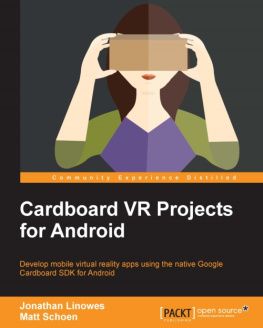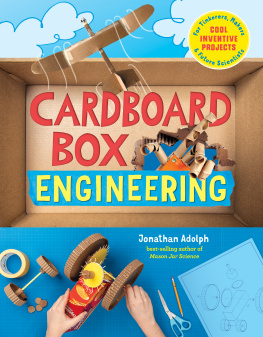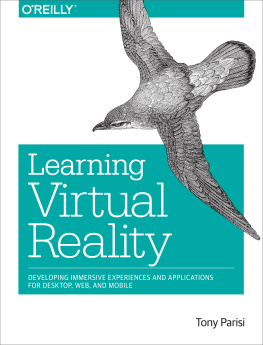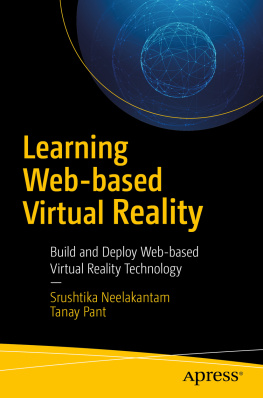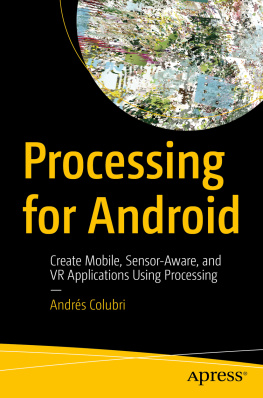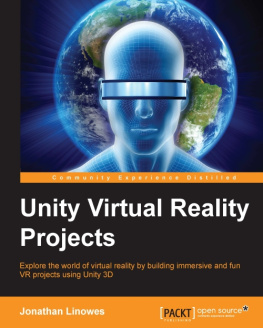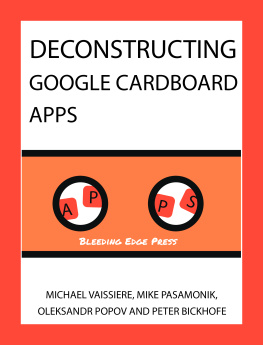Cardboard VR Projects for Android
Copyright 2016 Packt Publishing
All rights reserved. No part of this book may be reproduced, stored in a retrieval system, or transmitted in any form or by any means, without the prior written permission of the publisher, except in the case of brief quotations embedded in critical articles or reviews.
Every effort has been made in the preparation of this book to ensure the accuracy of the information presented. However, the information contained in this book is sold without warranty, either express or implied. Neither the authors, nor Packt Publishing, and its dealers and distributors will be held liable for any damages caused or alleged to be caused directly or indirectly by this book.
Packt Publishing has endeavored to provide trademark information about all of the companies and products mentioned in this book by the appropriate use of capitals. However, Packt Publishing cannot guarantee the accuracy of this information.
First published: May 2016
Production reference: 1120516
Published by Packt Publishing Ltd.
Livery Place
35 Livery Street
Birmingham B3 2PB, UK.
ISBN 978-1-78588-787-1
www.packtpub.com
Credits for the Cover Image:
Custom Illustration designed by eLearning Mind, LLC., www.eLearningMind.com, ELM creates interactive learning experiences using modern brain science and intuitively stunning design.
The DIY Virtual Reality article: http://elearningmind.com/diy-virtual-reality-world-of-warcraft-thinks-inside-the-box-at-comic-con-2015/
Credits
Authors
Jonathan Linowes
Matt Schoen
Reviewers
Scott Dolim
Oleksandr Popov
Commissioning Editor
Edward Gordon
Acquisition Editor
Reshma Raman
Content Development Editor
Sachin Karnani
Technical Editor
Siddhi Rane
Copy Editor
Rashmi Sawant
Project Coordinator
Nikhil Nair
Proofreader
Safis Editing
Indexer
Hemangini Bari
Graphics
Kirk D'Penha
Production Coordinator
Shantanu N. Zagade
Cover Work
Shantanu N. Zagade
About the Authors
Jonathan Linowes is the owner of Parkerhill Reality Labs, a start-up VR/AR consultancy firm. He is a VR and 3D graphics enthusiast, full-stack web developer, software engineer, successful entrepreneur, and teacher. He has a fine arts degree from Syracuse University and a master's degree from the MIT Media Lab. He has founded several successful start-ups and held technical leadership positions at major corporations, including Autodesk Inc. He is also the author of the Unity Virtual Reality Projects book by Packt Publishing.
Matt Schoen is the cofounder of Defective Studios and has been making VR apps since the early DK1 days. Still in the early stages of his career, he spent most of his time working on Unity apps and games, some for hire and some of his own design. He studied computer engineering at Boston University and graduated with a BS in 2010, at which point he founded Defective with Jono Forbes, a high-school friend. He has been making games and apps ever since. Matt was the technical lead on Defective's debut game, CosmoKnots, and remains involved in Jono's pet project, Archean. This is his first foray into authorship, but he brings with him his experience as an instructor and curriculum designer for Digital Media Academy. Jono and Matt have recently joined Unity's VR Labs division, where they will be helping to create experimental new features which will shape the VR landscape for years to come.
About the Reviewers
Scott Dolim has worked on and off in 3D computer graphics for over 20 years, including a 5-year stint at Walt Disney Feature Animation in the 1990s. More recently, for the last 5 years, he has been actively involved in virtual reality development, mostly with Unity 3D. Scott currently works at Google where he is the lead engineer of the Cardboard SDK for Unity.
Oleksandr Popov is a developer of numerous 3D apps, mainly live wallpapers, for Android devices. His first experience with 3D for Android started in 2012 when with the release of Android 2.2, it became possible to create live wallpapers. Since then, he has released about 15 of them in collaboration with his brother, Dmytro, who is responsible for creating 3D scenes. After releasing each app, he gained more and more experience in OpenGL ES. Basically, he tried almost every new feature of Android where 3D and OpenGL can be applied. He started with live wallpapers in Android 2.2, then he added support of the daydream mode for them in 4.2. He started using some of the features of OpenGL ES 3.0 introduced in Android 4.3. And as soon as Google added support of custom watch faces for Android Wear 5.0, he and his brother created a set of 3D watch faces for smart watches too. Of course, after Google announced Cardboard, he immediately decided to create VR apps for this platform as well.
He and his brother are also coauthors of the Deconstructing Google Cardboard Apps book by Bleeding Edge Press.
www.PacktPub.com
eBooks, discount offers, and more
Did you know that Packt offers eBook versions of every book published, with PDF and ePub files available? You can upgrade to the eBook version at > for more details.
At www.PacktPub.com, you can also read a collection of free technical articles, sign up for a range of free newsletters and receive exclusive discounts and offers on Packt books and eBooks.
https://www2.packtpub.com/books/subscription/packtlib
Do you need instant solutions to your IT questions? PacktLib is Packt's online digital book library. Here, you can search, access, and read Packt's entire library of books.
Why subscribe?
- Fully searchable across every book published by Packt
- Copy and paste, print, and bookmark content
- On demand and accessible via a web browser
Preface
Google Cardboard is a low-cost, entry-level medium used for experiencing virtual 3D environments. Its applications are as broad and varied as mobile smartphone applications themselves. This book gives you the opportunity to implement a variety of interesting projects for Google Cardboard using the native Java SDK. The idea is to educate you with best practices and methodologies to make Cardboard-compatible mobile VR apps and guide you through making quality content appropriate for the device and its intended users.
What this book covers
, Virtual Reality for Everyone , defines Google Cardboard, explores it, and discusses how it's used and how it fits in the spectrum of VR devices.
, The Skeleton Cardboard Project , examines the structure of a Cardboard app for Android, takes a tour of Android Studio, and helps you build a starter Cardboard project by introducing the Cardboard Java SDK.
, Cardboard Box , discusses how to build a Cardboard Android app from scratch (based on Google's Treasure Hunt sample) with a 3D cube model, transformations, stereoscopic camera views, and head rotations. This chapter also includes discussions of 3D geometry, Open GL ES, shaders, matrix math, and the rendering pipeline.

